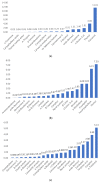Chemical and Biochemical Characterization of Essential Oils and Their Corresponding Hydrolats from Six Species of the Lamiaceae Family
- PMID: 34834852
- PMCID: PMC8619938
- DOI: 10.3390/plants10112489
Chemical and Biochemical Characterization of Essential Oils and Their Corresponding Hydrolats from Six Species of the Lamiaceae Family
Abstract
Many plants belonging to the Lamiaceae family are rich in essential oils (EOs) which are intensively used for aromatherapy, food and beverage flavoring, alternative medicine, cosmetics, and perfumery. Aerial parts of Thymus vulgaris L., Thymus pannonicus All., Lavandula angustifolia L., Lavandula x intermedia, Origanum vulgare L., and Origanum vulgare var. aureum L. were subjected to hydrodistillation, and both resulting fractions were analyzed. The purpose of this study was to determine the chemical composition, antioxidant activity, and total phenolic content of six essential oils and their corresponding hydrolats (HDs) through GC-MS and spectrophotometric analyses. Overall, 161 compounds were identified, some found exclusively in essential oils and others in hydrolats, making them individual products with specific end purposes. The total phenolic content was the highest for the Thymus vulgaris L. EOs (3022 ± mg GAE L-1), because of its high phenolic oxygenated monoterpenes content (thymol and carvacrol) and the smallest for the Lavandula angustifolia L. EOs (258.31 ± 44.29 mg GAE L-1), while hydrolats varied from 183.85 ± 0.22 mg GAE L-1 for Thymus vulgaris L. HD and 7.73 mg GAE L-1 for Thymus pannonicus All. HD. Significant antioxidant effects determined through DPPH• and ABTS•+ assays were also observed in samples with higher hydrophilic compounds. The highest antioxidant activity was determined for Thymus vulgaris L. EO and its corresponding HD. Although EOs are the principal traded economic product, HDs represent a valuable by-product that could still present intense antiseptic activities, similar to their corresponding EOs (thyme and oregano), or have multiple aromatherapy, cosmetics, and household applications (lavender and lavandin).
Keywords: GC-MS; antioxidant activity; bioactive compounds; by-product valorization; essential oils; hydrolats.
Conflict of interest statement
The authors declare no conflict of interest.
Figures





Similar articles
-
Use of Pinus sylvestris L. (Pinaceae), Origanum vulgare L. (Lamiaceae), and Thymus vulgaris L. (Lamiaceae) essential oils and their main components to enhance itraconazole activity against azole susceptible/not-susceptible Cryptococcus neoformans strains.BMC Complement Altern Med. 2018 May 3;18(1):143. doi: 10.1186/s12906-018-2219-4. BMC Complement Altern Med. 2018. PMID: 29724221 Free PMC article.
-
Phytochemical Analysis, Antimicrobial and Antioxidant Properties of Thymus zygis L. and Thymus willdenowii Boiss. Essential Oils.Plants (Basel). 2021 Dec 22;11(1):15. doi: 10.3390/plants11010015. Plants (Basel). 2021. PMID: 35009019 Free PMC article.
-
Chemical composition and bioactivity of essential oils and Ethanolic extracts of Ocimum basilicum L. and Thymus algeriensis Boiss. & Reut. from the Algerian Saharan Atlas.BMC Complement Altern Med. 2019 Jun 21;19(1):146. doi: 10.1186/s12906-019-2556-y. BMC Complement Altern Med. 2019. PMID: 31227024 Free PMC article.
-
Bioactive Natural Compounds and Antioxidant Activity of Essential Oils from Spice Plants: New Findings and Potential Applications.Biomolecules. 2020 Jul 1;10(7):988. doi: 10.3390/biom10070988. Biomolecules. 2020. PMID: 32630297 Free PMC article. Review.
-
Chemical Composition, Enantiomeric Distribution, Antimicrobial and Antioxidant Activities of Origanum majorana L. Essential Oil from Nepal.Molecules. 2022 Sep 19;27(18):6136. doi: 10.3390/molecules27186136. Molecules. 2022. PMID: 36144869 Free PMC article. Review.
Cited by
-
Multistep Approach Points to Compounds Responsible for the Biological Activity and Safety of Hydrolates from Nine Lamiaceae Medicinal Plants on Human Skin Fibroblasts.Antioxidants (Basel). 2023 Nov 9;12(11):1988. doi: 10.3390/antiox12111988. Antioxidants (Basel). 2023. PMID: 38001841 Free PMC article.
-
Volatile Components, Antioxidant and Phytotoxic Activity of the Essential Oil of Piper acutifolium Ruiz & Pav. from Peru.Molecules. 2023 Apr 10;28(8):3348. doi: 10.3390/molecules28083348. Molecules. 2023. PMID: 37110583 Free PMC article.
-
The Effect of Peppermint and Thyme Oils on Stabilizing the Fatty Acid Profile of Sunflower Oil.Molecules. 2024 Jan 5;29(2):292. doi: 10.3390/molecules29020292. Molecules. 2024. PMID: 38257205 Free PMC article.
-
Repellent activity against Anopheles gambiae of the leaves of nesting trees in the Sebitoli chimpanzee community of Kibale National Park, Uganda.Malar J. 2022 Sep 27;21(1):271. doi: 10.1186/s12936-022-04291-7. Malar J. 2022. PMID: 36163024 Free PMC article.
-
Disclosing the Functional Potency of Three Oxygenated Monoterpenes in Combating Microbial Pathogenesis: From Targeting Virulence Factors to Chicken Meat Preservation.Foods. 2024 Mar 21;13(6):965. doi: 10.3390/foods13060965. Foods. 2024. PMID: 38540955 Free PMC article.
References
-
- Garzoli S., Petralito S., Ovidi E., Turchetti G., Laghezza Masci V., Tiezzi A., Trilli J., Cesa S., Casadei M.A., Giacomello P., et al. Lavandula x intermedia essential oil and hydrolate: Evaluation of chemical composition and antibacterial activity before and after formulation in nanoemulsion. Ind. Crops Prod. 2020;145:112068. doi: 10.1016/j.indcrop.2019.112068. - DOI
-
- Šilha D., Švarcová K., Bajer T., Královec K., Tesařová E., Moučková K., Pejchalová M., Bajerová P. Chemical Composition of Natural Hydrolates and Their Antimicrobial Activity on Arcobacter-Like Cells in Comparison with Other Microorganisms. Molecules. 2020;25:5654. doi: 10.3390/molecules25235654. - DOI - PMC - PubMed
-
- Ramawat K.G., Mérillon J.M. Natural Products: Phytochemistry, Botany and Metabolism of Alkaloids, Phenolics and Terpenes. Springer; Berlin/Heidelberg, Germany: 2013.
-
- Diass K., Brahmi F., Mokhtari O., Abdellaoui S., Hammouti B. Biological and pharmaceutical properties of essential oils of Rosmarinus officinalis L. and Lavandula officinalis L. Mater. Today-Proc. 2021;45:7768–7773. doi: 10.1016/j.matpr.2021.03.495. - DOI
Grants and funding
LinkOut - more resources
Full Text Sources
Miscellaneous

